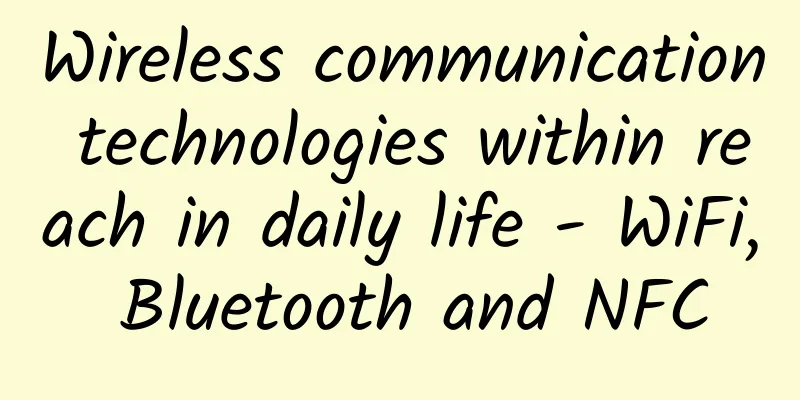Wireless communication technologies within reach in daily life - WiFi, Bluetooth and NFC

WiFiWi-Fi (Wireless Fidelity) is a wireless LAN technology that uses wireless signals to connect devices and networks. Wi-Fi technology allows users to transfer data and access the Internet through wireless signals without the need for wired connections. Wi-Fi technology has become an indispensable part of modern life and is widely used in various occasions such as homes, offices, commercial places and public areas. WiFi technology originated in 1997 and was invented by scientists from Australia's CSIRO (Commonwealth Scientific and Industrial Research Organisation). They used a technology called "OFDM" (Orthogonal Frequency Division Multiplexing) to successfully increase the data transmission speed to 2Mbps. This technology was later incorporated into the IEEE 802.11 standard and became the basis of WiFi technology. Mainstream WiFi standards
WiFi Security
These methods can help improve the security of your Wi-Fi network, but you also need to be careful to regularly check and update security settings to address new security threats. BluetoothBluetooth is a wireless technology used to transmit data over a short distance. It is commonly used to connect mobile phones, headphones, speakers, keyboards, mice and other devices. Bluetooth technology enables wireless communication and data transmission between devices. Bluetooth originated in 1994 and was developed by Ericsson engineers Jaap Haartsen and Sven Mattisson. Initially, their goal was to develop a technology that could enable wireless communication between mobile phones and other portable devices. With the development of technology, Bluetooth has become a widely used standard for short-range wireless communication between various devices. Common Bluetooth versions
The development trend of Bluetooth technology
The development trend of Bluetooth technology will continue to move towards low power consumption, high-speed transmission, Mesh network, positioning navigation and security. NFCNFC stands for "Near Field Communication", which is a short-range wireless communication technology that allows devices to communicate without contact or at a very short distance. NFC is commonly used in the fields of mobile payment, access control systems, smart tags, etc. In NFC communication, devices communicate through radio waves, and the typical working distance is within a few centimeters. NFC technology originated in 2002 and was jointly developed by Philips and Sony. It is based on RFID (Radio Frequency Identification) technology and can perform wireless communication and data transmission within a short distance. NFC technology was originally used in mobile payment, smart tags, and data transmission, and is now widely used in scenarios such as mobile payment, public transportation cards, and access control systems. NFC operating modes
Common application scenarios of NFC
Comparison of WiFi, Bluetooth and NFC
|
<<: GSMA: 5G SA and 5G-A are booming, and operators will continue to increase investment
>>: What is a router in a network? Core functions explained
Recommend
Do you know the role of API Gateway?
[[266934]] API Gateway The following three scenar...
How powerful is 5G? Talking about the development and evolution of the new generation of communication technology
Although 5G communication technology has always b...
When Wi-Fi 6 enters the home, car and other industry markets, modules become the key players!
"What's the Wi-Fi password here?" I...
Overview of the five major 5G wireless technologies
Two of the five most important wireless technolog...
[11.11] UFOVPS 30% off, top up 200 yuan and get 20 yuan, Japan/Hong Kong CN2 GIA/US high defense optional
UFOVPS has launched a promotion during the Double...
Ministry of Industry and Information Technology: Nearly 850,000 5G base stations have been built, forming the world's largest 5G independent networking network
According to the Ministry of Industry and Informa...
What is Bluetooth Low Energy?
Bluetooth Low Energy is a new Bluetooth wireless ...
How does DNS work? See how this "translator" converts domain names and IP addresses
[[277197]] 1. What is DNS? DNS (Domain Name Syste...
In the era of instant messaging, what else can 5G bring us besides speed?
The 5G era is approaching, bringing more poetic i...
Towards the next generation of Internet, SoundNet releases full-link acceleration FPA to increase QoS protection for the Internet
On August 19, Agora held an online product launch...
5G packages in various countries are ridiculously expensive! How is 5G priced in my country?
In 2019, 5G communication technology gradually be...
Jiaxing Cloud Road: Tongxiang Smart Education and the 6 Major Projects Behind It
When the thousand-year-old ancient town Wuzhen wa...
Guangzhou Hongfang Zhou Jiaxing: Ruijie system engineer's growth story of "upgrading and fighting monsters"
Zhou Jiaxing, Director of the Authorized Service ...
What are some tips for installing home broadband that most people don't know? You need to know these things in advance
Broadband includes those from China Telecom, Chin...
5G message is coming, please check!
What is 5G messaging? Is it an upgraded version o...









